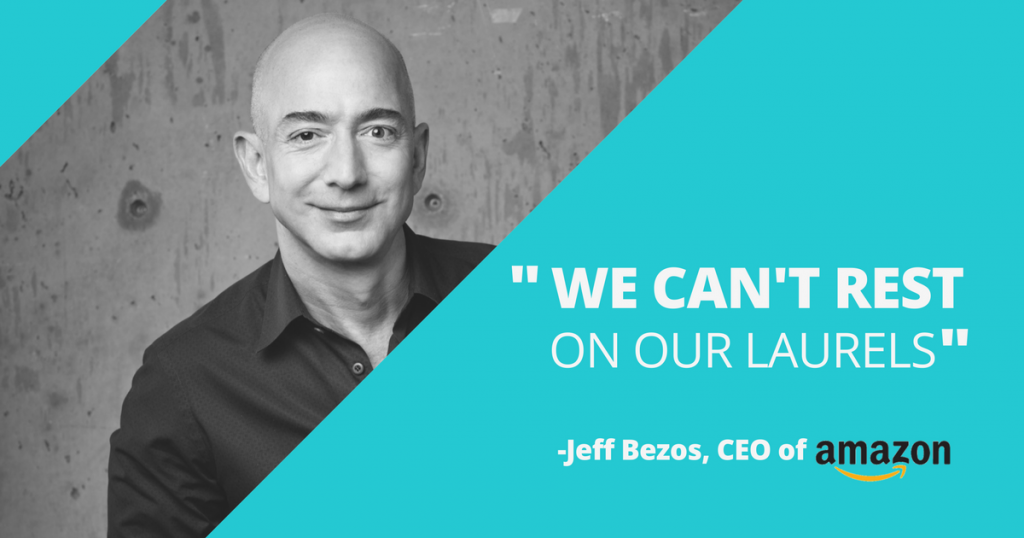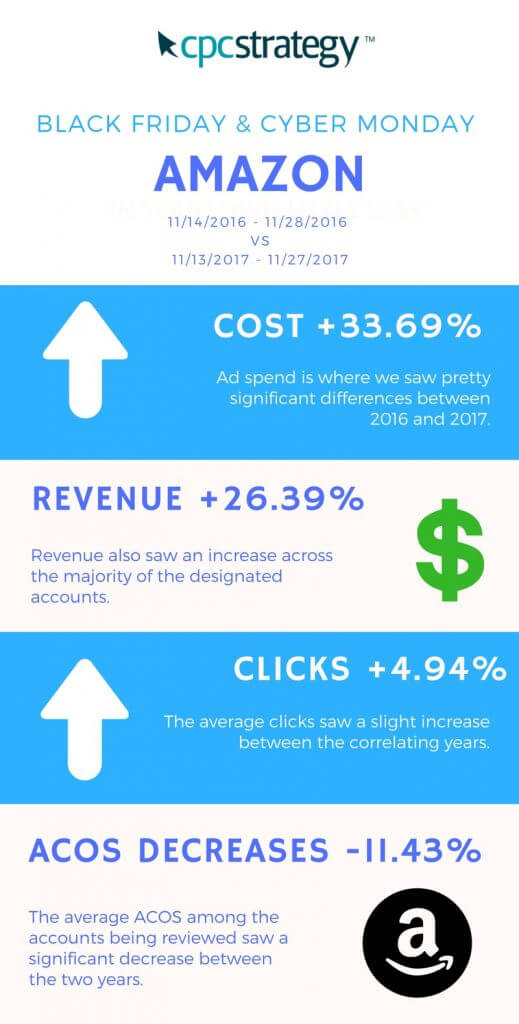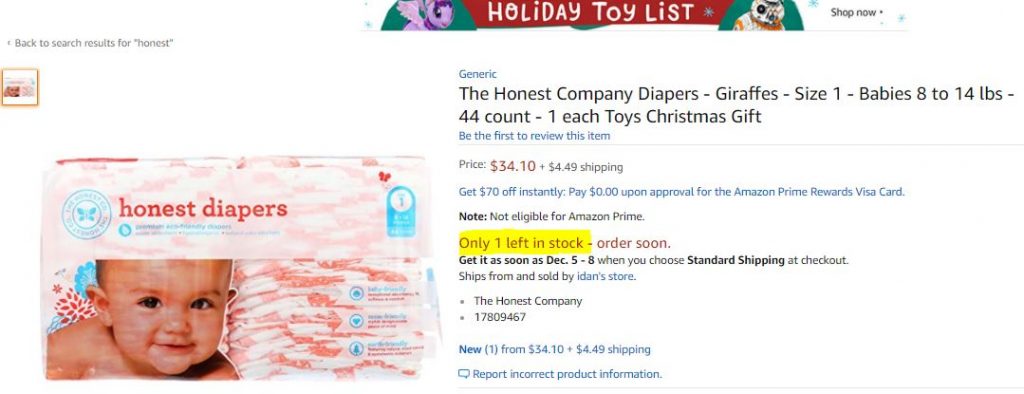It’s almost a no-brainer at this point.
Why wake up at 6am to battle the traffic and crowded stores when you can make holiday purchases from the comfort of your own home? They’ve coined the term “Couch Friday” as millions of holiday items are now being purchased via mobile, desktop and tablet devices.
It’s no surprise that Black Friday and Cyber Monday continue to serve as the biggest shopping days of the year. And by now, 64% of the country depends on: deep discounts, free delivery, and 2-day shipping (or less!) thanks to Amazon Prime.

According to reports, this year Amazon accounted for 7.14 million of 13 million transactions on Black Friday, and 5.64 million of the 12.5 million orders placed on Thanksgiving Day.
Amazon also announced its best-ever holiday shopping weekend for devices, with millions of Amazon devices sold between Thanksgiving and Cyber Monday including:
- Echo Dot and Amazon Fire TV Stick with Alexa Voice Remote (Best-selling products from any manufacturer in any category across all of Amazon.com)
- Fire TV Sticks (Customers purchased 2.7x as many as in the same period last year)
- Fire Kids Edition (Which continues to be the #1 kids tablet in the U.S., across all retailers)
- Echo Dot (Best-selling device at Whole Foods Market over the holiday weekend)

Other top selling items referenced include:
- What Do You Meme? Adult Party Game, $29.99
- GoPro HERO5 Black, $349
- Xbox One S 500GB Console, $189.00
- Tommy Hilfiger Men’s Packable Down Jacket, $50.00
Thanks to the need for shopping convenience (and the growing number of investors in the Marketplace), Amazon CEO Jeff Bezos is now worth more than $100 billion (Bloomberg).

“Thanksgiving, Black Friday and Cyber Monday all broke records this year and records will continue to be broken by Amazon as ecommerce grows,” Pat Petriello, Head of Marketplace Strategy at CPC Strategy said.
While we can take a look at Amazon’s Black Friday and Cyber Monday trends from an overall perspective, we also wanted to dive into the numbers and see how they compared year-over-year (YoY).
We gathered data on CPC Strategy clients that we managed between 2016 and 2017. The following data starts 2 weeks before Cyber Monday and ending on Cyber Monday (aka 11/14/2016 – 11/28/2016 vs. 11/13/2017 – 11/27/2017).

Takeaways From Amazon’s Black Friday & Cyber Monday
We also spoke with our Amazon Team at CPC Strategy to get their take on how the holiday weekend panned out:
1. Premature Sales Panic
Leading up to Black Friday, conversion rates were down but this isn’t something new.
“We see this every year and I imagine this will continue. There is a panic among Amazon sellers leading up to Black Friday, because during this time sales are dropping and conversion rate is falling.”

“What we have to remind our clients is that most people are not buying any items Sunday through Wednesday of the week leading up to Thanksgiving,” Petriello said.
People will start to buy on Thanksgiving (a trend unique to ecommerce) largely because they can make online purchases from the comfort of their home while spending time with their family and friends.
2. Sophisticated advertisers rise to the top
Conversion rates matter more now than ever before. With the increase in traffic, although you’re likely to have a lot more people clicking on your product detail page – how many of those shoppers convert?
“Amazon sellers who made the decision earlier in the year to invest in things like Enhanced Brand Content (EBC) and A+ Content are the ones who won out this year,” Petriello said.
The Marketplace is more competitive than it has ever been and will continue to be competitive. Businesses who want to profit from Amazon will have to be extremely granular with their advertising strategy throughout the remainder of the holiday season and into 2018.
For example, are you the type of seller who tossed 100 of your products into one ad bucket or did you optimized each item in your catalog, providing it with the best opportunity to succeed? These are the things you should consider.
3. Apparel & ad placement is growing on Amazon
Apparel, as a vertical is growing steadily on Amazon. One the biggest differences we noticed between 2016 and 2017 is the expansion of advertising space for categories such as apparel and jewelry.
Our team of experts noticed the shift in ad placements about 2 months ago.

“We used to run a search for ‘womens dress’ or ‘womens boots’ and at the time, there would only be Sponsored Product ad placements at the bottom of the SERP,” Jeff Coleman, VP, Marketplace Channels at CPC Strategy said.
“But now, you’re likely to see more placements and more ad visibility. If you made that same search 6 months ago, you probably would not have been served as many ads in those categories.”
4. Sellers who refuse to discount suffer
One thing to note this year is that we did notice a dip in sales for luxury beauty brands selling products such as makeup, perfume, and skin care. One of the common trends we noticed within this category is that most of the brands did not offer a discount during the holiday weekend.
“As a consumer, if I was looking for a new perfume, I would probably click on the ad to see if there was a deal,” Nancy-Lee McLaughlin Manager, Marketplace Channel at CPC Strategy said.

“But if that particular brand wasn’t offering any special Black Friday or Cyber Monday promotions, I would probably keep looking.”
The result? Low sales & high spend resulting in a missed opportunity to capitalize on the increase in traffic.
5. Inventory issues detrimental to sales
We see it every year – sellers hurt by inventory stockouts.
“If I were head of marketing for a brand, inventory preparation would be something that I would invest a tremendous amount of energy into,” Petriello said.
“The truth is, even if you do all your advertising efforts up front including Enhance Brand Content, building out a granular list of keywords, and running FBA – if you stock out on high volume shopping days you have essentially devalued all of your investment. I would view this as an area that a lot of businesses still get wrong.”

What a lot of sellers and vendors don’t realize is that although they are operating through FBA, Amazon in general can take a lot longer to process your inventory (compared to say Target) because you may have to individually label all of your items.
So even as a vendor if you hit a huge spike (in Product Orders) and it’s bigger than expected on a busy shopping day, you might stock out and not be able to get those shipments into FBA quickly enough to satisfy demand.
6. Staying aggressive in Q1:
As we’ve said many times in our webinars, having a sophisticated advertising strategy in preparation of Q4 is absolutely essential to a seller’s success.
“Q4 is essentially a spring board for 2018,” Petriello said.
In many ways, your holiday advertising strategy will feed into your Prime Day success and so on and so on.
“It’s an ongoing process of gathering reviews, sales velocity, and ranking against keywords. If you continue with that momentum it will help set you up for the next big shopping day and the next after that,” he said.
“Whereas if you manage your campaign strategy poorly (in Q4) with stockouts and bad reviews, then you’re likely to spend most of the following promotional period licking your wounds and trying to heal rather than accelerating.”
Another misconception we see among sellers is the desire to prematurely dial back their advertising budgets in January, but Q1 represents an enormous opportunity for revenue due to returns, gift cards, and cash in hand.
“We expect a big apparel push in January, building off of the ‘new year, new you”‘ campaigns,” Petriello said.
In general, apparel has a high instance of returns due to wrong size, color or fit so we expect there will be an influx of shoppers either returning items in exchange for something else or shopping for themselves.
For more information on Amazon Black Friday / Cyber Monday sales, email [email protected]
You Might Be Interested In












